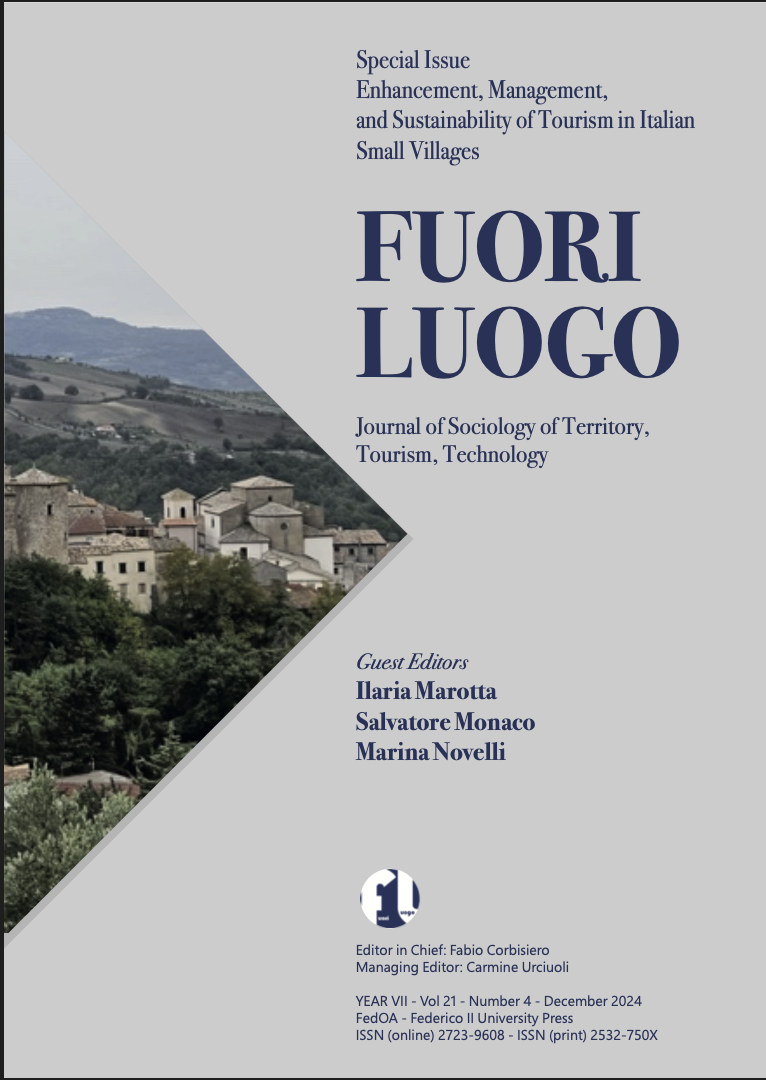The Case-Study of “Non-Tourist” Guidebook of Ussita. A Participatory Bottom-Up Approach to Place Branding and Tourism Destination Managem
DOI:
https://doi.org/10.6093/2723-9608/10760Keywords:
inland areas, participatory place branding, territorial indentity, Non-tourism GuideAbstract
In recent years, the theme of inland areas has assumed a relevant role in the public debate; inland areas, villages, fragile, marginal territories are spoken of as a new frontier of socio-cultural policies, but at the same time as places of social rebalancing, possible destinations of a more sustainable and slow tourism as garrisons of beauty, places of the country's material and immaterial heritage. These places have suffered abandonment and the reasons have been many and varied. However, the last few decades have led to the affirmation of strategies and practices that attempt a repopulation thanks to the presence of new inhabitants, young people, immigrants, new forms of entrepreneurship and unconventional tourism, capable of inserting these places in active and dynamic territorial contexts (Lucatelli, Luisi, Tantillo, 2022, Nigro, Lupo, 2020). This work will attempt to highlight the critical nature of development models where the valorisation of inland areas is only such if it is part of a hegemony of tourism understood as the gold or oil of Italy (D'Eramo, 2017, Barbera, Cersosimo and De Rossi, 2022).The work will attempt to show how it is necessary to prevent tourism from becoming an agent of deterritorialisation of inland areas and can instead contribute to the identification of new symbolic values and everyday use of these areas. Decades of patrimonialisation and mere valorisation, the result of an idea of territory destoricised and reduced to a mere figurative icon, have shown that the arrival of tourists has not automatically contributed to the reconstruction of the habitability of an inland area. So how can the limit of mere tourist development be overcome? Can inland areas open up to experiments in which participatory growth and circularity are mixed with culture and quality of life, forms of slow tourism, collective wellbeing and territorial identities? This work presents the Non-turismo project promoted by the cultural organisation Sineglossa, a series of guides to marginal places, whose aim is to bring together travellers and permanent residents of the same place. In particular, we will present The Non-Tourism Guide of Ussita, a village in the Sibillini Mountains in the Marche region, hit by the earthquakes of 2016 and 2017. Ussita is an inland area characterised by limited access to services, low income, marked physical and social marginalisation, an ageing population and the progressive depopulation of the territory. The objectives of this paper will be twofold. On the one hand, we will try to understand whether the Nonturismo project, which is "a way of understanding the encounter between a community and those from outside (...), where the community rediscovers its identity through a collective narrative" (https://sineglossa.it/progetti/nonturismo/) has allowed the resident community to renew a feeling of attachment to its territory through the narration of emotions and memories linked to this place. On the other hand, the work intends to argue how the Non-tourism project can present itself as an alternative to the increasingly widespread risk of typically urban behaviour developing in areas far from the city, offering tourists a different relationship with the ecosystem in which they are immersed. Part of the literature (Spanu, Nuvolati, 2020, Barbera, Cersosimo, De Rossi, 2022,) has in fact highlighted how, especially during the pandemic, a rhetoric of small towns considered as uncontaminated and high quality places has developed which, if not mitigated, risks encouraging the touristification exclusively aimed at the pleasure and enjoyment of city dwellers, which may lead to eco-gentrification (Carrosio, Magnani, Osti, 2019, Xu, Y., Wang, C. and Zhang, T. 2022) of these areas that ultimately empties them of inhabitants and economies.
Downloads
Downloads
Published
How to Cite
Issue
Section
License
Copyright (c) 2025 Paola De Salvo, Marco Pizzi

This work is licensed under a Creative Commons Attribution 4.0 International License.


